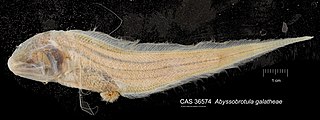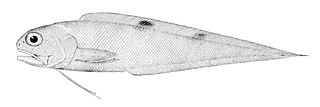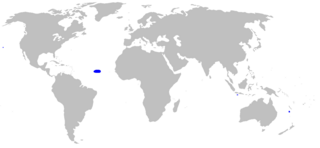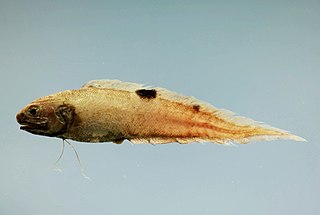Ophidiiformes is an order of ray-finned fish that includes the cusk-eels, pearlfishes, viviparous brotulas, and others. Members of this order have small heads and long slender bodies. They have either smooth scales or no scales, a long dorsal fin and an anal fin that typically runs into the caudal fin. They mostly come from the tropics and subtropics, and live in both freshwater and marine habitats, including abyssal depths. They have adopted a range of feeding methods and lifestyles, including parasitism. The majority are egg-laying, but some are viviparous.

The cusk-eel family, Ophidiidae, is a group of marine boney fishes in the order Ophidiiformes. The scientific name is from the Greek ophis meaning "snake", and refers to their eel-like appearance. True eels, however, diverged from other ray-finned fish during the Jurassic, while cusk-eels are part of the Percomorpha clade, along with tuna, perch, seahorses, and others. Unlike true eels of the order Anguilliformes, cusk-eels have ventral fins that are developed into a forked barbel-like organ below the mouth. In the true eels by contrast, the ventral fins are never well-developed and usually missing entirely.

The viviparous brotulas form a family, the Bythitidae, of ophidiiform fishes. They are known as viviparous brotulas as they generally bear live young, although there are indications that some species do not. They are generally infrequently seen, somewhat tadpole-like in overall shape and mostly about 5–10 cm (2–4 in) in length, but some species grow far larger and may surpass 60 cm (2 ft).

Abyssobrotula galatheae, is a species of cusk eel in the family Ophidiidae. It is the deepest-living fish known; one specimen, trawled from a depth of 8,370 m (27,460 ft) in the Puerto Rico Trench in 1970, holds the record for the deepest fish ever captured. Although generally recognized, some have suggested that the record-breaking individual might have been caught with a non-closing net and therefore perhaps caught shallower.
Onuxodon is an Indo-Pacific genus of pearlfishes from the family Carapidae. The generic name is derived from the Greek onyx meaning "claw" and odon meaning "tooth", referring to the sharp fang like teeth of Onuxodon parvibrachium. Species in this genus are distributed from South Africa to Hawaii. They live commensally with molluscs. The three currently recognized species are:
Bassogigas gillii is a species of cusk-eel found in the Indian, Pacific Ocean, and Atlantic Oceans at depths of from 637 to 2,239 metres.
Bassogigas is a genus of cusk eel from the subfamily Neobythitinae, part of the family Ophidiidae. The generic name "Bassogigas" comes from a combination of two Latin words: bassus, which means "deep" and gigas which means "giant". The species are found in the Indo-Pacific and western Atlantic Ocean.
Bassozetus is a genus of cusk-eels found in Atlantic, Indian and Pacific Ocean.

Neobythites is a genus of cusk-eels.

Otophidium is a genus of cusk-eels, part of the subfamily Ophidiinae in the family Ophidiidae. They are found in the western Atlantic and eastern Pacific.
Penopus is a genus of cusk-eels.

Sirembo is a genus of cusk-eels of the subfamily Neobythitinae, family Ophidiidae, which are found in the Indian and Pacific Oceans. The species in this genus have a rather robust body with the dorsal fin originating over vertebrae 1–5. The head and bod are completely covered in scales, they have large eyes which are almost equal in diameter to the length of snout, the pelvic fins have two rays which are joined together within an area of tough skin, They have a short spine on the operculum which does not extend to the posterior edge of the head. Their coloration is variable but almost all species have black spots or eyespots on the dorsal fin, sometimes both, while the middle part of the anal fin frequently has a black band. The body and/or head are marked with diagonal or horizontal dark stripes or horizontal rows of quite large dusky spots.
Spottobrotula is a genus of cusk-eels.
The East Pacific ventbrotula is a species of cusk-eel found around thermal vents on the southern East Pacific Rise at depths of about 2,586 metres (8,484 ft). This species grows to a length of 28.2 centimetres (11.1 in) SL. It is the only known member of its genus. The generic name is a compound of vent, for the Oasis hydrothermal vent on the south East Pacific Rise and the Greek ichthys meaning "fish", while the specific name refers to the French BIOSPEEDO expedition to the south East Pacific Rise which collected the type specimen in 2004.
The gargoyle cusk is a species of cusk-eel from the subfamily Neobythitinae of the family Ophidiidae. This species grows to a length of 57 centimetres (22 in) TL. It is the only known member of its genus. The specific name honours George S. Myers (1905-1985) of Stanford University who taught the describer, Daniel Cohen, ichthyology. It is a rare benthopelagic fish which occurs at depths of 984–2,500 metres (3,228–8,202 ft) around the world, other than the eastern Pacific, in tropical and subtropical latitudes.

Roche's snake blenny is a fish species in the genus Ophidion and the family Ophidiidae. Widespread in the Mediterranean Sea in western and northern regions, also in the Black Sea, Sea of Marmara and it has been recorded in the Atlantic. Marine subtropical demersal fish, up to 29.3 centimetres (11.5 in) long. The specific name honours the Swiss physician and naturalist François-Etienne Delaroche (1780-1813), who wrote about the distinctive swim-bladder anatomy of Ophidion barbatum in 1809.
Brotulotaenia brevicauda is a benthopelagic marine fish species in the family Ophidiidae. This totally black fish is usually found in the Atlantic Ocean but it has also been reported in the Indian. B. brevicauda lives in deep water and grows up to 32 cm in length. It is also occasionally known as the Short-tail cusk-eel.

Holcomycteronus profundissimus, also known by its synonym Grimaldichthys profundissimus, is a species of deep-sea fish in the cusk-eel family.

Neobythitinae is a subfamily of cusk eel from the family Ophidiidae. They are mostly fishes of deeper waters, occurring from the continental shelf down to as deep as 8,370 metres (27,460 ft) at the bottom of the Puerto Rico trench where the deepest known fish, Abyssobrotula galatheae, has been taken.

Ophidiinae is a subfamily of the cusk eel family Ophidiidae. The species in the subfamily are characterised by having their pelvic fins situated far forward on the body and supported by an forward orientated extension of the pelvic girdle, they lack barbels on the mouth and chin and they are covered in small cycloid scales arranged in horizontal or diagonal rows. Some species have a modified swim bladder and the anterior vertebrae which enables them to generate sounds. and some of these modifications are sexually dimorphic and make the fish capable of generating sound. They have two rays in each ventral fin and the caudal fin has 9 rays. Most species are benthic and occur on the continental shelf.









